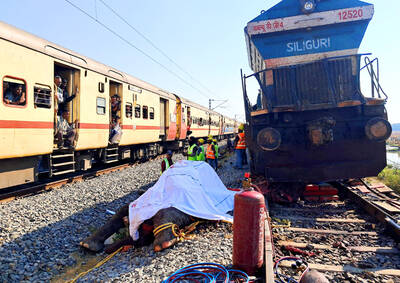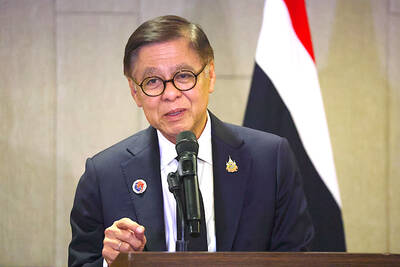Tajikistan’s mountainous Gorno-Badakhshan Autonomous Oblast (GBAO) is home to a rickety highway that is among the world’s great road adventures.
However, the region famed for its lunar landscapes and verdant valleys has a darker side. In the past few weeks, Tajikistan’s authoritarian government has cracked down hard on the restive region, which borders China and Afghanistan, and which tried to break away from Dushanbe in 1992.
At least 17 people were killed and more than 200 arrested during what the authorities call “an anti-terror operation,” with a communications blackout limiting information coming out of the region.
However, critics say that the real aim of the crackdown is to crush local leaders, who in the past have resisted Tajik President Emomali Rakhmon’s rule.
State information bulletins have trumpeted the operation as a success.
The state information service Khovar on Friday said that “12 leaders of organized criminal groups” had been detained during the operation and 16 people “neutralized” after resisting arrest.
“The activities of organized terrorist groups on the territory of Badakhshan have been completely stopped,” the service reported.
Authorities last month said that one member of the security services was killed during fighting.
Raids in the region followed anti-government protests last month and triggered a joint statement of “deep concern” from France, Germany, the UK and the US.
The Internet blackout has been criticized by rights groups, while private media outlet Asia-Plus said it ceased reporting on the situation “under threat of closure” by authorities.
Hemmed in by the towering Pamir Mountains and further isolated by poor transport infrastructure, Gorno-Badakhshan accounts for about half of Tajikistan’s territory, but only 2 percent of the nation’s 9.5 million population. Its peoples mostly speak languages distinct from the official Tajik spoken elsewhere in the former Soviet republic and follow Ismaili Shia Islam, rather than the nationally prevalent Sunni Islam.
Yet it is the isolated region’s penchant for political opposition, stretching back to a civil war in the 1990s, that rankles with the regime in the capital, activists say.
“They want to impose the same order on us that they have imposed elsewhere in Tajikistan. The order of one corrupt family,” said Alim Sherzamonov, an opposition leader who fled to Europe, referring to Rakhmon and his powerful family members.
Sherzamonov, deputy chairman of the diaspora-led National Alliance of Tajikistan, is one of several activists the government has accused of fomenting protests that set the stage for the operation.
The pro-autonomy demonstrations followed tensions between locals and centrally appointed officials, accused of carrying out campaigns of persecution.
Dozens of citizens of Pamiri descent living in Tajikistan have since been arrested “on ethnic grounds,” Sherzamonov said.
He denied having any role in the protests and said that his brother, who is not politically active, had been detained in the sweeps.
“This operation really started over a decade ago. They have reached their aim,” Sherzamonov said. “Many people are losing the will to keep fighting for their freedom.”
The violence is the worst in the region since 2012, when dozens died during clashes between government forces and fighters loyal to local informal leaders.
China — Tajikistan’s top foreign investor and largest creditor — has reportedly set up a base in the strategic region.
Beijing has not officially acknowledged the facility’s existence, but Tajikistan last year said that China was helping it build a separate base where Tajik special forces would be stationed.
The men named in Tajik state media reports of the latest deaths and arrests are recognized as informal leaders in Gorno-Badakhshan, which sits along the heroin trail that heads north from Afghanistan across the Panj River.
Some of them fought against troops loyal to Rakhmon during the civil war and were later handed government security posts as part of a peace deal that Tajikistan’s ally Russia helped broker.
However, none of the men held state positions at the time the new operation began, an indication that the government grew tired of power-sharing, observers say.
One particularly popular local leader, Mamadbokir Mamadbokirov, was killed “as a result of internal clashes of criminal groups,” police said last month, contradicting opposition reports that said Mamadbokirov was slain by government forces.
Zafar Abdullayev, a Tajik journalist who lives in the US, last month said in a YouTube broadcast that authorities’ simultaneous descriptions of the men as gangsters, terrorists and narcotics kingpins “do not withstand scrutiny.”
“They throw in all these different terms to say: They are bad guys,” Abdullayev said.
John Heathershaw, a professor of international relations at the University of Exeter said Tajikistan’s “authoritarian approach to conflict management” has done little to solve tensions in the troubled region.
“[The regime] systematically takes out rivals that challenge its domination over the economy, political space and public discourse,” Heathershaw said.

REVENGE: Trump said he had the support of the Syrian government for the strikes, which took place in response to an Islamic State attack on US soldiers last week The US launched large-scale airstrikes on more than 70 targets across Syria, the Pentagon said on Friday, fulfilling US President Donald Trump’s vow to strike back after the killing of two US soldiers. “This is not the beginning of a war — it is a declaration of vengeance,” US Secretary of Defense Pete Hegseth wrote on social media. “Today, we hunted and we killed our enemies. Lots of them. And we will continue.” The US Central Command said that fighter jets, attack helicopters and artillery targeted ISIS infrastructure and weapon sites. “All terrorists who are evil enough to attack Americans are hereby warned

‘POLITICAL LOYALTY’: The move breaks with decades of precedent among US administrations, which have tended to leave career ambassadors in their posts US President Donald Trump’s administration has ordered dozens of US ambassadors to step down, people familiar with the matter said, a precedent-breaking recall that would leave embassies abroad without US Senate-confirmed leadership. The envoys, career diplomats who were almost all named to their jobs under former US president Joe Biden, were told over the phone in the past few days they needed to depart in the next few weeks, the people said. They would not be fired, but finding new roles would be a challenge given that many are far along in their careers and opportunities for senior diplomats can

Seven wild Asiatic elephants were killed and a calf was injured when a high-speed passenger train collided with a herd crossing the tracks in India’s northeastern state of Assam early yesterday, local authorities said. The train driver spotted the herd of about 100 elephants and used the emergency brakes, but the train still hit some of the animals, Indian Railways spokesman Kapinjal Kishore Sharma told reporters. Five train coaches and the engine derailed following the impact, but there were no human casualties, Sharma said. Veterinarians carried out autopsies on the dead elephants, which were to be buried later in the day. The accident site

RUSHED: The US pushed for the October deal to be ready for a ceremony with Trump, but sometimes it takes time to create an agreement that can hold, a Thai official said Defense officials from Thailand and Cambodia are to meet tomorrow to discuss the possibility of resuming a ceasefire between the two countries, Thailand’s top diplomat said yesterday, as border fighting entered a third week. A ceasefire agreement in October was rushed to ensure it could be witnessed by US President Donald Trump and lacked sufficient details to ensure the deal to end the armed conflict would hold, Thai Minister of Foreign Affairs Sihasak Phuangketkeow said after an ASEAN foreign ministers’ meeting in Kuala Lumpur. The two countries agreed to hold talks using their General Border Committee, an established bilateral mechanism, with Thailand